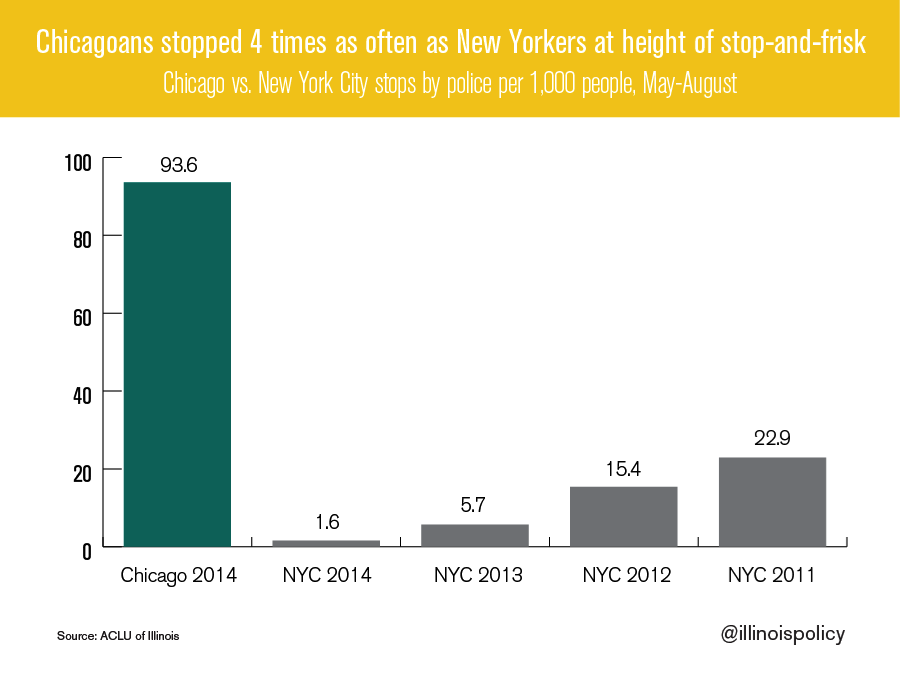Chicagoans 60 times more likely than New Yorkers to be stopped by police
Chicago residents are stopped four times as often as New York City residents were at the height of that city’s controversial stop-and-frisk policy.
A review of the Chicago Police Department’s use of “stop-and-frisk” tactics has revealed systemic abuse and gross negligence in monitoring the practice.
Under the law, officers may stop you if they have reason to suspect you have been, are, or are about to be engaged in criminal activity. Once you are stopped, officers may frisk you if they suspect you have a weapon.
Though police often claim this practice is necessary to curb violent crime, there is no compelling evidence that use of stop-and-frisk on a massive scale in New York City reduced levels of homicide, robbery or aggravated assaults. In fact, the involuntary stops have been shown to degrade police legitimacy in communities that could benefit from positive police relations the most.
The American Civil Liberties Union of Illinois released a study on March 23 titled “Stop and Frisk in Chicago.” Among the most disturbing findings was that in the summer of 2014, Chicago police made more than 250,000 stops without an arrest. Chicagoans were stopped 58 times as much as New Yorkers in the same time period, and four times as much as New Yorkers at the peak of that city’s controversial stop-and-frisk policy.
A great deal of the stops in Chicago were conducted without reasonable cause. According to the ACLU’s study, “Although officers are required to write down the reason for stops, in nearly half of the stops we reviewed, officers either gave an unlawful reason for the stop or failed to provide enough information to justify the stop.”
Heavy use of stop-and-frisk disproportionately harms Chicago’s black residents. While they only constitute 32 percent of the city’s population, black Chicagoans were subjected to 72 percent of the stops.
“These stops don’t make us safer, they simply drive a wedge further between the police and the public they serve,” said Karen Sheley, senior legal council at the ACLU of Illinois. “What this data shows should be a wake-up call for residents of the city.”
Unfortunately, Chicago only records information about stop-and-frisks if there is no arrest or charges. This means the rates of innocent Chicagoans stopped or frisks resulting in seizure of contraband can’t be determined. New York City does collect this data: a mere 6 percent of the stops resulted in arrests and 2 percent of the frisks resulted in the recovery of weapons in 2012. These statistics were foundational in the fight to develop more effective practices at the New York City Police Department.
In the short term, the ACLU suggests the city moves to remedy this information gap by requiring CPD to collect publicly available data on all stop-and-frisks. In order to better facilitate complaints associated with police harassment via stop-and-frisks, receipts – similar to what are given for traffic stops in Illinois – should be issued for each police interaction.
Body cameras for police officers would likely cut down on the need to file complaints in the first place. In Rialto, California, complaints dropped 88 percent in a single year when half of the city’s police force began using body cameras. Use of force fell by nearly 60 percent.
Fortunately, the future for this equipment in Illinois looks bright. The Chicago Police Department is formulating a body-camera pilot program. Deputies and correctional officers in DeWitt County are already wearing them. And the Illinois Association of Chiefs of Police has come out in support of body cameras.
In the meantime, it appears stop-and-frisk is heavily overused in Chicago to the detriment of marginalized communities and city dwellers at large.
Image credit: J.Knecht

